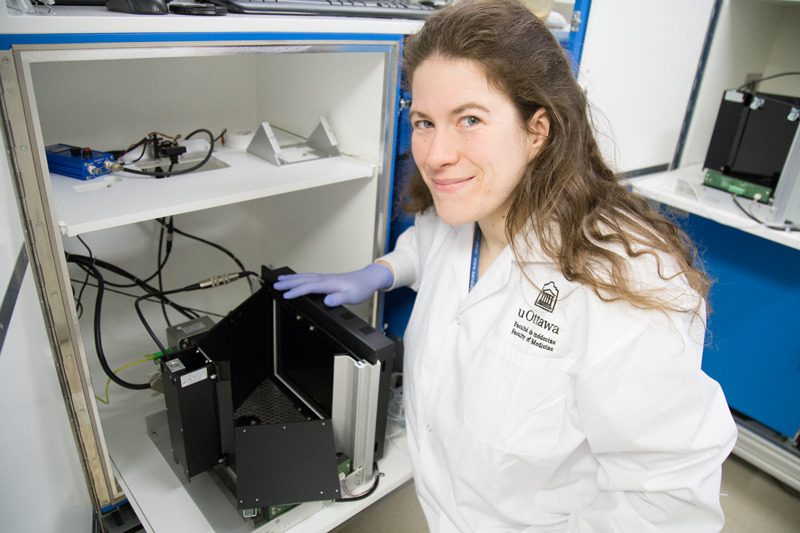The study of the behaviour of preclinical animal models provides critical insight into a host of human diseases. Since 2009, the Faculty of Medicine’s Behavioural Core has offered an array of services in rodent behaviour analysis to help researchers find answers to their scientific questions.
To meet the varying needs of the scientific community, over 60 behaviour and physiological tests for mice and rats are offered by the Behavioural Core. Scientists are able to study in animal models how behaviour and physiology is modified without a gene of interest, or by therapeutics drugs in preclinical testing. In addition to disease models, many laboratories are rising to the challenge and using animal models to understand what underlies complex behaviours such as learning, memory and attention.
Researchers can then translate what they learn into human therapies for anxiety and depression, developmental disorders, and motor recovery following stroke, to name a few.
The strength of this core is that the researchers, animal care and the Behavioural Core teams work in partnership to determine their precise needs of each project, and to ensure the team has the resources they need to maximize outcomes, as well as the approved protocol(s) needed for the work.
“We’ll meet with you face to face to understand your requirements, and if you need help we are here to help design a plan to complement your research,” explains Dr. Kerstin Ure, manager of the Behavioural Core. “Our highly trained technician can then provide the necessary training and technical assistance at every stage of a project.”
The Behavioural Core has seen its users double in the last 5 years as word spreads of its state-of-the-art services. Collaborations with the Faculty’s own experts in methods such as optogentics and artificial intelligence are also two examples of how the Core is ensuring it remains at the forefront of the animal behaviour field.
The diversity of projects carried out at the Core is of mutual benefit to users and the Core team, promoting sharing of knowledge and refinement of practices. Members of the Faculty of Medicine community make up half of the Core’s users, with the balance from partner hospitals and research institutes, other uOttawa faculties, and elsewhere in the research community.
“Anyone in need of animal behavioural or physiological analyses is welcome to use the services, including external to the uOttawa community through contracts,” says Dr. Ure.
The Core welcomes any questions from the research community. “Teamwork is at the heart of the Faculty of Medicine,” Dr. Ure says. “Let us help you make your research shine.”
Visit the website or contact them at any time at [email protected].
The Behavioural Core team:
- Diane Lagace, PhD - Director
- Kerstin Ure, PhD - Manager
- Mirela Barclay - Technician
- Sarah Kealey – Technician
- Karine Sabourin – ACVS and Behavioural Core Shared Technician
Main photo: A mouse is recorded while walking on the Digigait, an automated method of measuring the gait of animal that is often used in studies of Parkinson’s or MS, for example. Photo credit: Joanne Steventon
The Behavioural Core facility: One of 13 cores at the Faculty of Medicine
With support from affiliated hospital-based research institutes and the University of Ottawa, the Faculty has successfully developed a series of cutting-edge core facilities that bring together state-of-the-art equipment, instrumentation, methodologies and expertise crucial to the success of basic and clinical research activities. These facilities are accessible to all researchers across the University of Ottawa as well as to outside communities on a fee-for-service basis.
To date, 13 cores have been established and a few others are in the planning stages. For each facility, a director and user committees have been appointed to ensure accountability and optimal use for the continued commitment and success of our expanding core facilities.
|
Dr. Diane Lagace |
|
|
Dr. Michael Rudnicki |
|
|
Dr. Theodore Perkins |
|
|
Dr. Daniel Figeys |
|
|
Dr. John Copeland |
|
|
Dr. William Stanford |
|
|
Dr. Laura Trinkle-Mulcahy |
|
|
Dr. John Veinot |
|
|
Dr. Marc-André Langlois |
|
|
Dr. Frank J. Rybicki |
|
|
Dr. Marc-André Langlois |
|
|
Dr. Daniel Figeys |
|
|
Dr. David Lohnes |
|
| Metabolomics: |
Dr. Julie St-Pierre |
| Transmission Electron Microscopy: |
Dr. Baptiste Lacoste |
For more information, please visit the Core Facilities website.


